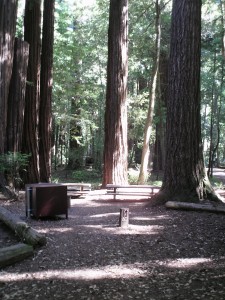Where to Go
In the United States of America there are private and public areas for camping.
Private Areas
The most well known private areas are KOA or Kampgrounds of America. These campgrounds are located outside of parks and offer showers, washers and dryers, electricity, campsites where you can set your tent or trailer and sometimes a small store. http://koa.com/
Public Areas
The areas most used by the public are the government campgrounds. These campgrounds can be divided into “City Parks”, “County Parks”, “State Parks” and “Federal Parks”. The “State Parks” and the “Federal Parks” campgrounds are typically used the most.
State Parks
State parks are administered by the state in which they are located. These parks generally provide numbered campsites for setting up a tent or parking a trailer or RV, bathrooms, showers, trails, fire-rings, picnic tables, drinking water pumps and campsites with or without electricity. Sometimes state parks also have concession stands that sell ice, snacks and firewood.
During the summer, many of these parks offer free presentations led by park rangers. These presentations can cover a wide range of topics including animals, plants, stars, park history and more. Link to state parks here (an internal link to a list of links)
Costs
The cost of admission varies from one state to another and sometimes from one park to another. The cost of admission is for the use of the state park facilities for the day. If you want to camp in the park, you need to pay an additional fee.
Saving money
One possible way to save money is to buy an annual pass. This pass allows unlimited use of the state park for day use. If you are going to be visiting the states parks on a regular basis, this pass will save you money.
Federal Parks and Lands
Federal Parks can be divided into the following four types: National Parks, National Forest, Bureau of Land Management also called the BLM and the Army Corps of Engineers Lakes.
National Parks
The National Parks are the most well known parks in the United States because they include such parks as Yellowstone in Wyoming, the Grand Canyon in Arizona, Yosemite in California, Everglades in Florida and Acadia in Maine, but there are many other parks to choose from.
The purpose of these parks is to protect national treasures in the areas of biodiversity, archeology and national history.
The majority of these parks offer numbered campsites for setting up a tent or parking a trailer, public bathrooms, picnic tables, fire-rings, drinking water pumps, free educational programs, hiking trails, a map of the trails and a gift shop. As a side note, showers are not always available, especially in the western United States due to a lack of water.
Costs
If you want to use the National Park for day, you need to pay at the park entrance for this type of use. The fee you pay for the day will grant you and the people in your personal vehichle admission to the park for seven days. Like the state parks, if you want to camp in the park there is an additional fee for each night you want to camp.
If the entrance fee for using a park stretches your budget a little too far check out these dates for free admission to certain parks in 2012. http://www.nps.gov/findapark/feefreeparks.htm
If you are going on a long trip and visiting several National Parks it may be worth buying an annual pass for $80. Here is the federal governments description of the pass.
NATIONAL PASSES: America the Beautiful – National Parks and Federal Recreational Lands Pass Program
Beginning in January 2007, the National Park Service will join the USDA Forest Service, Fish and Wildlife Service, Bureau of Land Management, and Bureau of Reclamation in the new Interagency Pass Program. This program provides pass holders access into any federal recreation site—including Acadia—that charges an entrance or standard amenity fee; some passes also offer discounts on other fees, such as camping. Each pass admits the pass holder and passengers in a non-commercial vehicle at per vehicle fee areas and pass holder plus three adults, not to exceed four adults, at per person fee areas. (Children under 16 are admitted free.)


